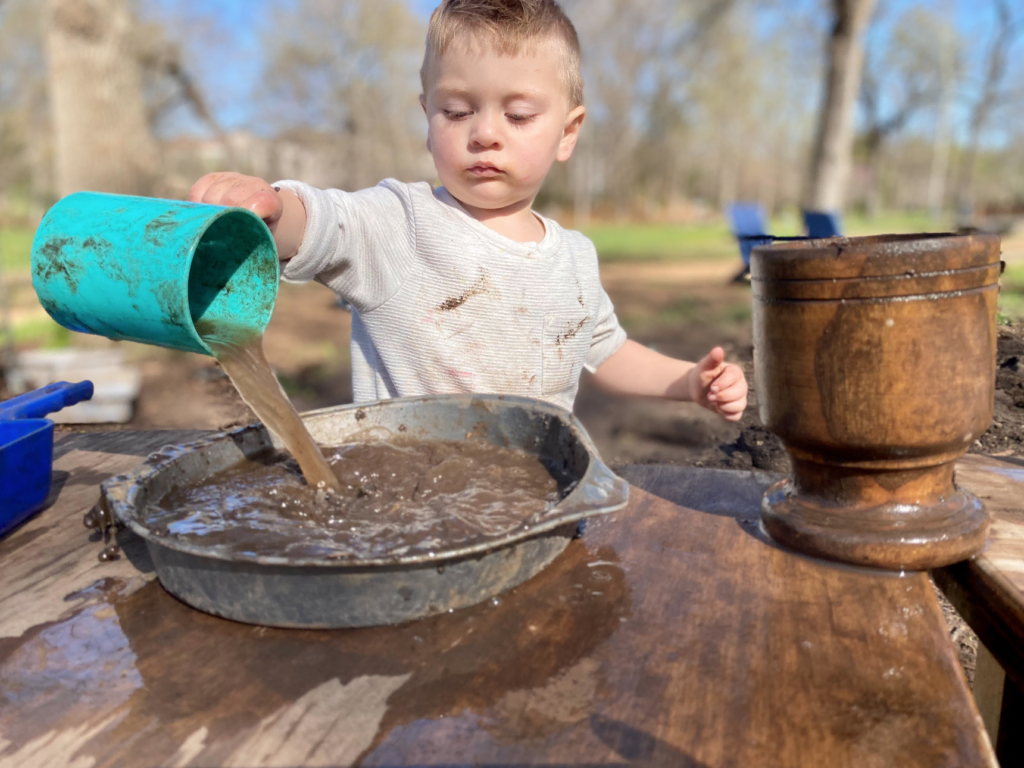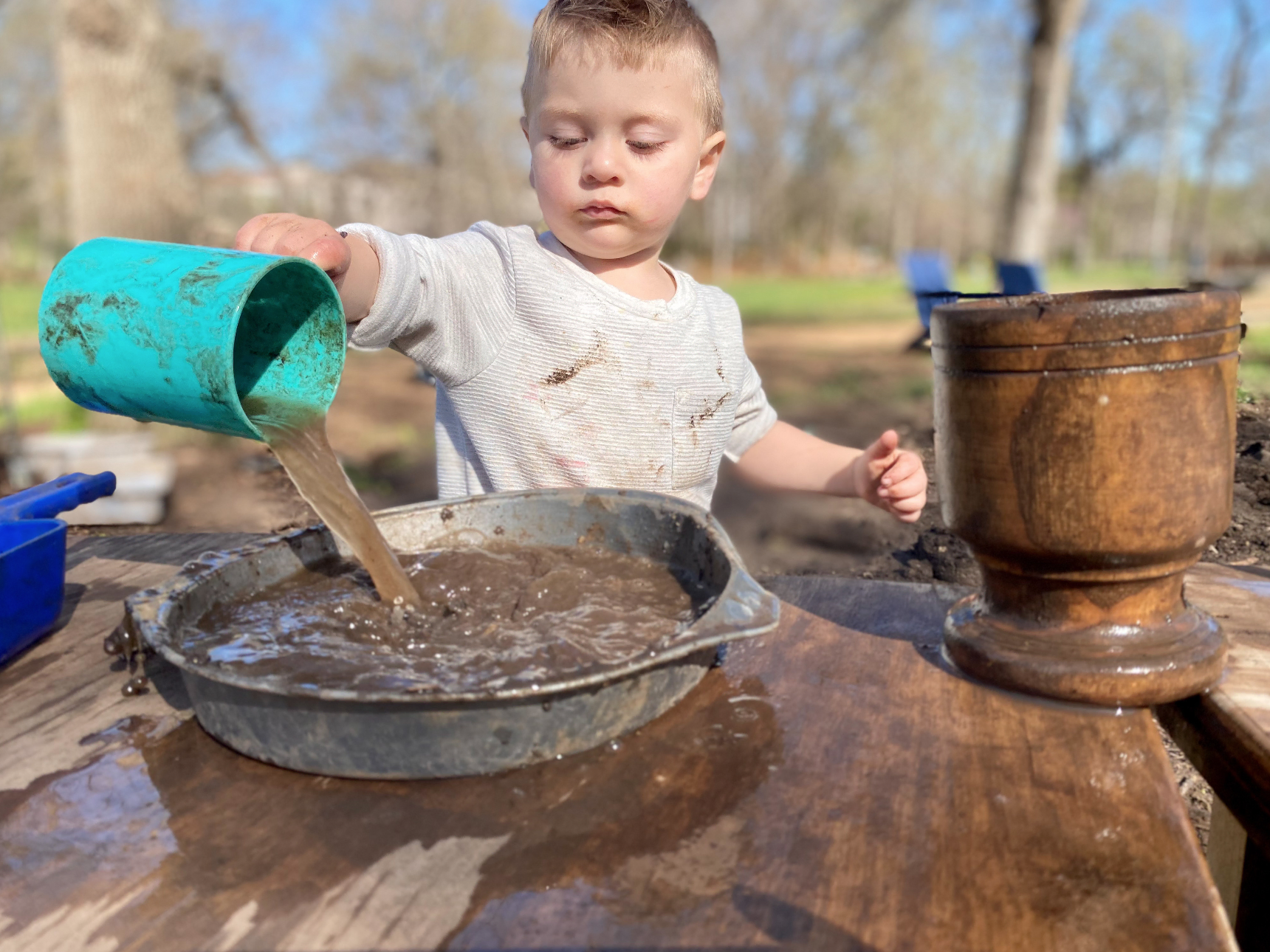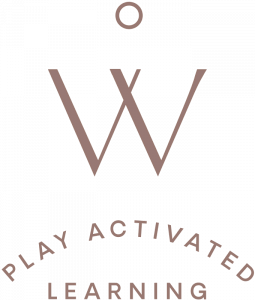
As an early years educator, it’s not uncommon to face comments from parents who may not understand or appreciate your teaching approach. However, it’s crucial to be able to respond to these comments in a professional and informed way. It’s a delicate balance of professionalism, knowledge, and empathy.
It’s essential to reassure parents that their child is receiving high-quality education and that we take our responsibility for their children’s development and well-being seriously. So, appreciate their curiosity and desire to learn more about their children’s education.
Below we have listed some common comments parents make, and although we know there’s no such thing as one fits all solution, you can reflect on these responses and adapt them to your context:
1. “What do you do all day? Are the children just playing all the time?”
2. “This place is a disgrace, it’s so messy!”
3. “But this is so chaotic, children just run around.”
4. “I don’t see any evidence of learning or progress.”
6. “Why aren’t you teaching my child anything?”
8. “My child needs to be stimulated, otherwise he gets bored.”
9. “My child needs rules, I want him to learn how to behave.”
11. “What will you do if a child does not want to play?”
12. “How will my child learn what they need to know for kindergarten/grade 1?”
Effective Responses to Common Parents’ Concerns
1. “What do you do all day? Are the children just playing all the time?”
Answer: “While it may look like the children are just playing, they are actually engaging in purposeful, meaningful activities that help them develop important skills and knowledge. For example, they may be building with blocks, which helps them develop spatial awareness and problem-solving skills, or exploring nature, which helps them learn about science concepts like transformation, scale, and systems, and get familiar with the world around them. We carefully plan and design our activities to ensure that they are aligned with children’s interests and abilities, while also supporting their learning and development.”
- It’s important for the educator to help parents understand that play is a valuable and purposeful part of a child’s learning and development. By engaging in play, children are able to explore and make sense of the world around them, develop important skills and knowledge, and build social connections with their peers. As educators, we carefully plan and design activities that align with children’s interests and abilities, while also promoting their learning and growth. So while it may look like the children are just playing, they are actually engaging in activities that are intentional, purposeful, and meaningful.
2. “This place is a disgrace, it’s so messy!”
Answer: “We understand that a play-based learning environment can appear messy at times, but we want to assure you that this is an intentional aspect of our approach. Our goal is to create an environment that is both engaging and stimulating for children, and research has shown that messy play can be particularly effective in achieving this. Messy play allows children to explore and experiment with a variety of materials and textures, which is important for their sensory development and overall learning. In addition, it promotes creativity, problem-solving, and imagination, which are essential skills for success in all areas of life. While we do encourage children to clean up after themselves and take responsibility for their play area, we also recognize that some mess is a natural part of the learning process. Rest assured that we have a plan in place to maintain a safe and hygienic learning environment for all children.”
- It’s important for the educator to emphasize that the perceived messiness of the play-based learning environment is actually an intentional and important aspect of the approach. The educator could also reassure the parent that they are committed to working together with them to address any concerns they may have about cleanliness or hygiene.
“The benefit of having the loose parts presented as a ‘mess’ or ‘junk pile’ is the simple fact that the opportunities to create are greatly enhanced due to no specific start or end point being suggested for the children. The mess also ensures that children are far less likely to be fearful of making mistakes as they cannot exactly make the environment any messier! In fact, the entire premise of ‘a mistake’ is largely removed in an outcomes-free setting and is replaced with ideas such as “what should I try instead?”, “why didn’t that work?” and “ah, what if I did this instead?”
Angus Ian Gorrie
From Angus Ian Gorrie’s article A Playworker’s Musings on the Perceptions and Importance of ’Mess’ in a Play Space
3. “But this is so chaotic, children just run around.”
Answer: “We understand that the level of activity and movement in a play-based learning environment may seem chaotic at first glance, but we want to assure you that our approach is designed to support children’s learning in a purposeful and intentional way. In fact, research has shown that children learn best when they are actively engaged in their environment and have opportunities to explore and experiment with a variety of materials and experiences. Our role as educators is to provide a safe and supportive environment in which children can do this. We do this by providing a variety of materials and experiences that are developmentally appropriate, and by guiding and facilitating children’s play in a way that promotes learning and socialization. We also observe and track each child’s progress and use this information to plan future experiences that build upon their interests and abilities. While it may seem chaotic on the surface, our play-based approach is actually quite structured and purposeful, helping children develop important skills such as creativity, problem-solving, and socialization.”
- It’s important for the educator to emphasize that the play-based approach is not a free-for-all, but rather a purposeful and intentional approach to learning that is designed to meet the needs of young children. The educator could also invite the parent to observe their child’s play in the classroom to see firsthand how engaged and purposeful their play is.
4. “I don’t see any evidence of learning or progress.”
Answer: “We assure you that your child is indeed making progress in their development and learning. In our approach, learning is integrated into all aspects of play and daily activities, rather than being confined to specific lessons or activities. We also place a strong emphasis on the process of learning, rather than just the end product. This means that we encourage children to take risks, make mistakes, and learn from their experiences, rather than simply focusing on achieving a specific outcome. We also use a variety of observation and documentation techniques to track each child’s progress and development, such as pedagogical documentation, which provides a rich and detailed record of a child’s learning journey. We would be happy to share these observations and documentation with you so that you can see for yourself the progress that your child is making. We believe that our approach helps children to develop a love of learning and a strong foundation for future academic success.”
- It’s important for the educator to explain how learning is integrated into play-based experiences and how progress is tracked and documented. By sharing documentation and observations with parents, educators can provide concrete evidence of their child’s learning and progress. Emphasizing the value of process-oriented learning and risk-taking can also help parents understand the unique benefits of a play-based curriculum.
5. “I don’t see any worksheets or formal assessments. How will I know if my child is making progress?”
Answer: “We believe that play-based learning is the most effective way for young children to learn and develop and that formal assessments and worksheets are not necessary at this stage. Instead, we use a variety of observation and documentation techniques to track children’s progress and growth, including pedagogical documentation, which is a detailed record of children’s learning and development that we share with parents. We also communicate regularly with parents and provide opportunities for them to see their child’s progress firsthand through classroom activities, performances, and parent-teacher conferences.”
- It’s important for the educator to emphasize that assessments and worksheets are not the only indicators of a child’s progress and that young children often learn best through play and hands-on experiences. By using observation and documentation techniques, we can provide a more holistic view of a child’s development, and by involving parents in the learning process, we can work together to support their child’s growth and learning.
Download this list of common parents’ concerns and expert tips in a comprehensive ebook format.
6. “Why aren’t you teaching my child anything?”
Answer: “We understand that as a parent, you want to see your child making progress and learning new things. Rest assured that our approach is centered around providing children with meaningful learning experiences that are both engaging and age-appropriate. Our play-based curriculum is designed to support the development of a wide range of skills, including problem-solving, communication, creativity, and critical thinking. We believe that learning is most effective when it is integrated into a child’s play experiences, which is why we encourage children to explore and experiment with a variety of materials and activities. Our approach also emphasizes the importance of child-led learning, which means that we follow the child’s interests and ideas, rather than imposing a set curriculum on them. By doing so, we are able to provide each child with a personalized and unique learning experience that is tailored to their individual needs and interests. We believe that this approach not only helps children to develop a love of learning but also prepares them for success in all areas of life.”
- It’s important for the educator to emphasize the value of play-based learning and its ability to support the development of a wide range of skills. The educator could also reassure the parent that their child is indeed learning and making progress, even if it may not be immediately visible or in a traditional sense. By highlighting the personalized and child-led nature of the approach, the educator can help the parent understand the unique benefits of a play-based curriculum.
7. “Why isn’t my child learning specific skills like reading and writing?” “I want you to teach my child to read and write and do math.”
Answer: “We understand your desire for your child to develop strong literacy and numeracy skills, and we agree that these are important foundational skills for future success. Play-based learning is supported by decades of research in neuroscience and early childhood education that shows Play is the most effective approach for young children to develop not only strong foundational skills but also higher-order thinking skills, creativity, and social-emotional competence. By engaging in play-based learning, children are able to make connections between new experiences and prior knowledge, which helps to reinforce learning and facilitate retention. As a result, play-based learning has been shown to lead to better academic outcomes in the long term, as well as positive social and emotional development. Our play-based approach actually supports the development of these skills in a variety of ways. For example, we incorporate literacy and numeracy activities into our play-based curriculum, such as storytelling, rhyming games, and counting games, which help children develop early literacy and numeracy concepts. We also provide opportunities for children to explore and experiment with written language and numbers in a developmentally appropriate way. Through these activities, we help children develop a love of learning that will serve them well as they continue to build their skills in these areas.”
- It’s important for the educator to emphasize that the play-based approach is not opposed to academic learning, but rather supports it in a way that is developmentally appropriate for young children. They could also reassure the parent that they are committed to providing a rich and stimulating learning environment that supports the child’s development in all areas, including academics.
8. “My child needs to be stimulated, otherwise he gets bored.”
Answer: “We understand your concern and want you to know that our play-based approach is specifically designed to keep children engaged and stimulated. Through play, children are given opportunities to explore and learn about the world around them in a way that is meaningful and interesting to them. We provide a variety of open-ended materials and experiences that encourage children to use their imaginations and creativity to come up with their own ideas for play. Additionally, we observe and track each child’s interests and abilities, and use this information to provide experiences that are tailored to their individual needs. We also encourage collaboration and socialization, which can be very stimulating for children. Through these strategies, we are able to provide a learning environment that is both engaging and challenging, helping your child develop a lifelong love of learning.”
- It’s important for the educator to emphasize that the play-based approach is not only engaging and stimulating, but also fosters the development of key skills such as creativity, problem-solving, and socialization. The educator could also invite the parent to observe their child’s play in the classroom to see firsthand how engaged and stimulated they are.
9. “My child needs rules, I want him to learn how to behave.”
Answer: “We understand your desire for your child to learn appropriate behavior and want you to know that our play-based approach actually supports the development of social and emotional skills, including self-regulation and behavior management. In a play-based environment, children have the opportunity to practice decision-making, problem-solving, and conflict-resolution skills in a safe and supportive setting. We provide clear guidelines for behavior that are developmentally appropriate and reinforce positive behavior through verbal praise and other forms of positive reinforcement. We also model appropriate behavior and provide guidance and support to children who may be struggling with behavior management. Through these strategies, we help children learn important life skills such as empathy, respect, and responsibility, which are essential for success in all areas of life.”
- It’s important for the educator to emphasize that the play-based approach is not opposed to the development of appropriate behavior, but rather supports it in a way that is developmentally appropriate for young children. The educator could also reassure the parents that they are committed to working together with them to support their child’s development and address any concerns they may have.
10. “I’m worried that my child won’t be able to sit still and focus in a traditional classroom setting.”
Answer: “Our play-based approach helps children develop self-regulation skills, including the ability to focus and concentrate for longer periods of time. By providing a balance of active and quiet activities, and by using play-based techniques to introduce new concepts and ideas, we help children build their attention spans and develop a love of learning that will serve them well in any setting.”
- It’s important for the educator to emphasize to parents that children have varying developmental timelines and that the ability to sit still and focus is a skill that develops over time. Providing extended periods of uninterrupted play is one of the most effective strategies for helping children develop their attention spans and self-regulation skills, which are critical for success in any learning environment.
11. “What will you do if a child does not want to play?”
Answer: “If a child is not interested in playing, our first step would be to understand why. We will observe first and then, if we see the need to intervene, we will approach the child with sensitivity and respect, acknowledging their feelings and allowing them space to express themselves. We can suggest different activities or materials that the child may be interested in exploring, but we never force them to participate. Our role is to create a nurturing environment that encourages children to learn through play and exploration. However, it’s important to understand that children are unique individuals and may have different needs and preferences. Some may take more time to adapt to new situations, while others may jump right in. As educators, we recognize that children have different comfort levels and we strive to create an environment that supports each child’s individual needs. We also understand that some children may be observers at first, taking time to watch and absorb their surroundings. This does not mean they are not participating, as observation is an important aspect of learning and can help children feel more comfortable and confident as they begin to engage in play. Regardless of their level of engagement, we always make it clear to each child that we are available to them and that they are valued members of our learning community.”
- It’s important for the educator to emphasize that we always include every child in play and group work, but we do not force them to participate. Our approach is to encourage and support children to explore and learn through play in a way that is meaningful to them. Children are naturally curious and drawn to play, and by providing a play-based approach, we are able to focus on their social learning and allow them the time and space to build relationships at their own pace. With time, children will become engaged in play and develop strong social connections.
12. “How will my child learn what they need to know for kindergarten/grade 1?”
Answer: “Our play-based approach is designed to help children develop a strong foundation of skills and knowledge that will prepare them for success in grade 1 and beyond. Through hands-on, experiential learning, we help children develop critical thinking, problem-solving, and social-emotional skills, as well as foundational literacy and numeracy skills. We also work closely with grade 1 teachers to ensure that our program aligns with their expectations and requirements, and we provide ongoing support to help children transition smoothly to the next phase of their learning journey.”
- It’s important for the educator to communicate to parents that by offering a play-based approach that is developmentally appropriate for their children we are fostering a love of learning and providing a nurturing and supportive environment, so children will be well-prepared for success in grade 1 and beyond.
Download this list of common parents’ concerns and expert tips in a comprehensive ebook format.
Tips for helping families understand the value of play
- Explain how play is essential for children’s development and learning.
- Use simple language to describe different types of play, such as imaginative play, sensory play, and cooperative play, to enhance families’ comprehension of the diverse forms and benefits of play.
- Help families to see the connections between play and their child’s development by pointing out specific skills that children learn through play, such as problem-solving, social skills, and creativity.
- Invite families for a meeting to discuss the benefits of play and invite them to engage in play and reflect on their child’s learning and development.
- Use pedagogical documentation to show how children are learning through play.
- Use newsletters, blogs, and other communication tools to reinforce the relationships between your center and the families.
- Read everything you can and invest in professional development about play and child development, and practice talking about it with colleagues and friends so that you can better communicate with families.
- Encourage families to get involved in their children’s play-based learning experience and offer support for them to use similar materials at home (loose parts).
- Prepare a welcome pack for new families that includes your driving principles, values, and beliefs, what characterizes your approach, your philosophy, your inspirations, and some articles, books, and links parents can read to better understand your choices. You can also send them this blog post to anticipate some common concerns.
Conclusion
As early years educators, we have a responsibility to demonstrate our expertise and dedication to children’s learning and development. This means creating a safe and nurturing environment that encourages children to explore and experiment with different materials and ideas, providing opportunities for hands-on learning, and documenting and reflecting on children’s progress and growth.
By being transparent and open with parents about our approach and intentions, and by involving them in their child’s learning journey, we can build a strong foundation of trust and mutual respect. We can also demonstrate our commitment to ongoing professional development and learning, staying up-to-date on the latest research and best practices in the field.
Ultimately, we believe that by working together with parents and families, we can provide the best possible learning environment for children. When parents see the positive impact that our approach has on their child’s development and well-being, they not only become supporters of our work but also advocate for play-based education in their communities. So let’s continue to work together to create the best possible learning environment for children, and to inspire others to do the same.
REFERENCES
Gorrie, A. I. (2022). A Playworker’s Musings on the Perceptions and Importance of ’Mess’ in a Play Space. International Journal of Playwork Practice, 2(1), Article 1.
Stegelin, Dolores. (2005). Making the Case for Play Policy: Research-Based Reasons to Support Play-Based Environments. Young Children. 60.
Ward, Ute (2009). Working with Parents in Early Years Settings. Learning Matters.



